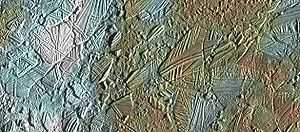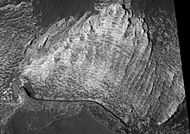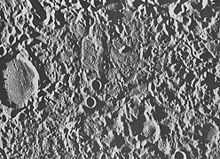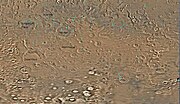Chaos terrain

In astrogeology, chaos terrain (or chaotic terrain) is a planetary surface area where features such as ridges, cracks, and plains appear jumbled and enmeshed with one another. Chaos terrain is a notable feature of the planet Mars, Mercury and Jupiter's moon Europa. In scientific nomenclature, "chaos" is used as a component of proper nouns (e.g., "Aureum Chaos" on Mars).[1]
On Mars
-
Map of Margaritifer Sinus quadrangle with major features labeled. Aureum Chaos is near the top of the map.
-
Huge canyons in Aureum Chaos, as seen by THEMIS. Gullies are rare at this latitude. Image from Margaritifer Sinus quadrangle.
-
Iani Chaos, as seen by THEMIS. Sand from eroding mesas is covering brighter floor material. Click on image to see relationship of Iani Chaos to other local features. Image from Margaritifer Sinus quadrangle.
-
Quadrangle map of Oxia Palus labeled with major features. This quadrangle contains many collapsed areas of Chaos and many outflow channels (old river valleys).
-
Erosion in Aram Chaos, as seen by THEMIS. Image in Oxia Palus quadrangle.
-
Blocks in Aram showing possible source of water, as seen by THEMIS. Image in Oxia Palus quadrangle.
-
Hydraotes Chaos, as seen by HiRISE. Click on image to seen channels and layers. Scale bar is 1000 meters long. Image in Oxia Palus quadrangle.
-
Hydaspis Chaos, as seen by HiRISE. Image in Oxia Palus quadrangle.
-

Light colored layers in Eos Chaos, as seen by HiRISE. Image is in Oxia Palus quadrangle.
-
Map of Phaethontis quadrangle. Click on to enlarge and see some crater names. Gorgonum Chaos is near the top of map.
-
Gorgonum Chaos as seen by Mars Reconnaissance Orbiter HiRISE. Image is 4 km wide. Image in Phaethontis quadrangle.
-
Atlantis Chaos, as seen by HiRISE. Click on image to see mantle covering and possible gullies. The two images are different parts of the original image. They have different scales. Image in Phaethontis quadrangle.
-

Ister Chaos, as seen by HiRISE. Location is the Lunae Palus quadrangle.
-
Close-up of Ister Chaos, as seen by HiRISE. Location is the Lunae Palus quadrangle.
On April 1, 2010, NASA released the first images under the HiWish program in which just plain folk suggested places for HiRISE to photograph. One of the eight locations was Aureum Chaos.[2] The first image below gives a wide view of the area. The next two images are from the HiRISE image.[3]
-
THEMIS image of wide view of following HiRISE images. Black box shows approximate location of HiRISE images. This image is just a part of the vast area known as Aureum Chaos. Click on image to see more details.
-
Aureum Chaos, as seen by HiRISE, under the HiWish program.
-
Close up view of previous image, as seen by HiRISE under HiWish program. Small round dots are boulders.
On Mercury
-

Caloris Basin
Causes
The specific causes of chaos terrain are not yet well understood. A number of different astrogeological forces have been offered as causes of chaos terrain. On Europa, impact events and subsequent penetration into a ductile or liquid crust were suggested in 2004.[4] In November 2011, a team of researchers from the University of Texas at Austin and elsewhere presented evidence in the journal Nature suggesting that many "chaos terrain" features on Europa sit atop vast lakes of liquid water.[5] These lakes would be entirely encased in the moon's icy outer shell and distinct from a liquid ocean thought to exist farther down beneath the ice shell. Rather than an external impact, the authors propose a four-step model for producing the surface expressions (chaos terrain) and the shallow, covered lakes. Full confirmation of the lakes' existence will require a space mission designed to probe the ice shell either physically or indirectly, for example using radar.
On Mars chaos terrain is believed to be associated with the release of huge amounts of water. The Chaotic features may have collapsed when water came out of the surface. Martian rivers begin with a Chaos region. A chaotic region can be recognized by a rat's nest of mesas, buttes, and hills, chopped through with valleys which in places look almost patterned. Some parts of this chaotic area have not collapsed completely—they are still formed into large mesas, so they may still contain water ice.[6] Chaotic terrain occurs in numerous locations on Mars, and always gives the strong impression that something abruptly disturbed the ground. Chaos regions formed long ago. By counting craters (more craters in any given area means an older surface) and by studying the valleys' relations with other geological features, scientists have concluded the channels formed 2.0 to 3.8 billion years ago.[7]
In popular culture
- In the graphic novel Watchmen, Dr. Manhattan ponders upon the alternative viewpoints of existence, and says that Mars did not choose life, but rather "chaotic terrain".
See also
- Arachnoids
- Areas of chaos terrain on Mars
- Astrogeology
- Martian spiders
- Rilles
References
- ↑ Robert Roy Britt, "Chaos on Mars," Space.com
- ↑ http://uahirise.org/releases/hiwish-captions.php
- ↑ http://hirise.lpl.arizona.edu/ESP_016869_1775
- ↑ Ong, Lissa. "Evidence that chaos terrain on Jupiter's moon Europa is formed by crust-penetrating impacts", Geological Society of America Abstracts with Programs, Vol. 36, No. 5, p. 144
- ↑ Schmidt, Britney; Blankenship, Don; Patterson, Wes; Schenk, Paul (November 24, 2011). "Active formation of ‘chaos terrain’ over shallow subsurface water on Europa". Nature 479: 502–505. Bibcode:2011Natur.479..502S. doi:10.1038/nature10608. PMID 22089135.
- ↑ http://themis.asu.edu/features/aramchaos
- ↑ http://themis.asu.edu/features/hydraotes















